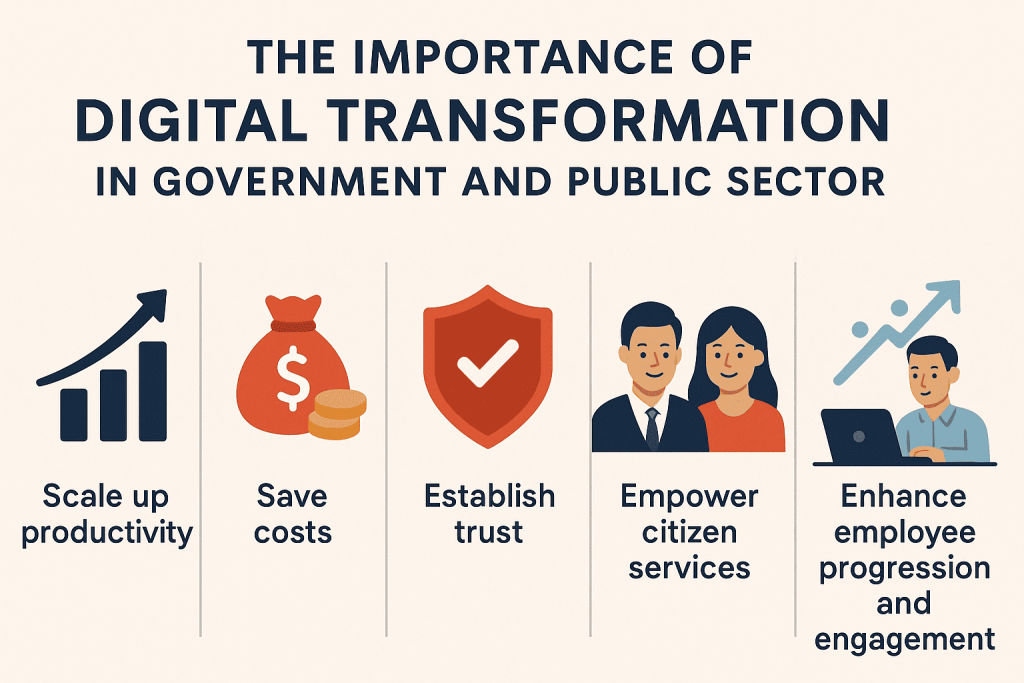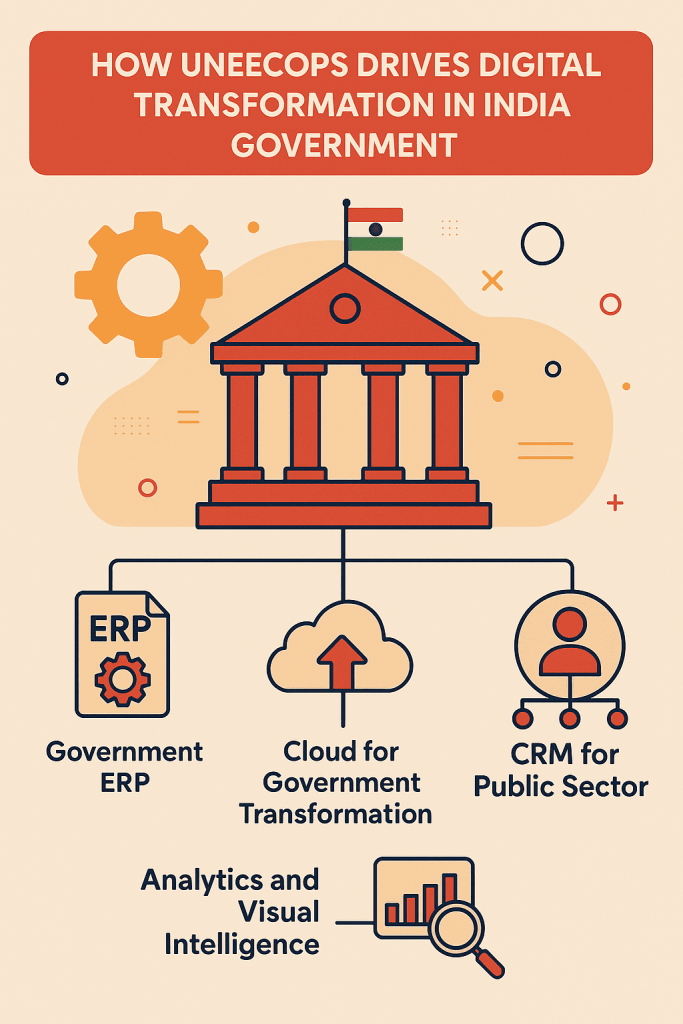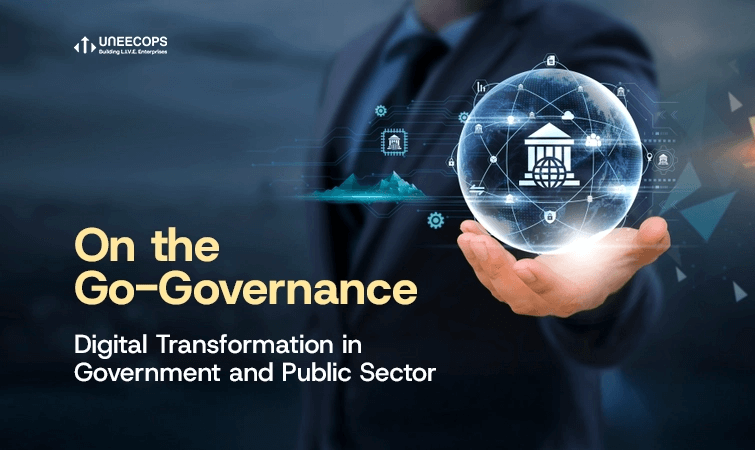Think of government sector in India and still what comes to your mind would be a person sitting in front of his pile of papers doing data entry or using an old desktop PC. It is true that governments have been slower than the private sector in adopting digital technologies to reimagine work processes, but the reality is that they have actually come a long way from their images in our minds. With digital transformation in government and public sector, the new era of ‘government on the go’ has come in.
In fact, digital transformation in government sector began in 2015, when our honorable Prime Minister, Shri Narendra Modi came up with the Digital Bharat program. As India dreamt to become digital, SMEs to large enterprises were shown the path to digital progression by the National e-Governance Division (NeGD), under the Ministry of Electronics and Information Technology (MeitY).
Undoubtedly, digital transformation for government has helped the private sector to ramp up its digital investments and also win big. The public sector, though slower in digital adoption, never lagged behind.
India’s government has a lot to take care of. With 1.4 billion citizens, streamlining public sector operations becomes inevitable. This blog explores the key elements of digital transformation in government sector in India, highlighting on the role of advanced technologies like Analytics, ERP, CRM, AI, and cloud computing. Let’s explore how digital transformation in Indian government services is redefining governance and public trust in 2025 and beyond.
What is Digital Transformation in Government Sector?
Digital transformation in the government and public sector refers to integrating advanced technologies like artificial intelligence (AI), cloud computing and big data into government operations. It boosts internal government processes and how public sector organizations deal with citizens. In India, the goal of this transformation is enhancing governance speed, transparency, and accessibility. Automating workflows means government officials can view insights anytime, anywhere and have all citizen data on a unified portal/platform.
Why is Digital Transformation in Government and Public Sector Necessary?
Legacy software platforms often hinder digital adoption. Modernizing IT infrastructure is essential for enhancing the interoperability and efficiency between government agencies. Developers can use low-code innovation to create applications faster using drag-and-drop interfaces rather than writing extensive code. This simplifies the backend hard work and enables quicker deployment of new government services.
So, digital transformation of government services is not just about adopting or implementing new technology. It’s about employing innovation and technology to sufficiently manage citizens’ demands by improving existing services and creating new routes for service delivery. Digital transformation helps governments:

- Scale up productivity: A unified platform with clear oversight of information and documents can save precious time with respect to searching for and updating data. Automation can also help cut out mundane manual tasks and streamline workflows, eliminating the need for things like manual data entry.
- Save costs: Although government allocations are usually tight, digital transformation optimizes procedures and systems, leading to substantial long-term cost savings.
- Establish trust: Digitization helps build trust between the state and its citizens by ensuring safe and transparent access to data. For instance, Riverside County in the U.S. used blockchain technology to contemporize public record-keeping, letting citizens receive vital documents securely within minutes.
- Empower citizen services: Citizens nowadays expect more from governments. Digital transformation allows public services to resolve citizen issues swiftly and provide unified data access, ensuring transparency.
- Enhance employee progression and engagement: Digital transformation also benefits government employees by streamlining processes, increasing productivity, and improving job satisfaction by offering career prospects.
The journey towards digital transformation in government and public sector is both exciting and rewarding but moving to on-the-go governance requires deploying tools that can take you there. As 2025 approaches, governments must consider.
The Role of Tech Tools in Public Sector Transformation
- ERP (Enterprise Resource Planning): ERP systems enable governments to centralize key functions like finance, procurement, and HR. This improves operational efficiency and accountability. More possibilities:
- Manage tax and revenue with in-depth data insights
- Digitize tax payment and collection
- Streamline pension experience
- Manage grants in a single system
- CRM (Customer Relationship Management): CRM technologies help governments manage interactions with citizens and offer personalized services. More possibilities:
- Enhance agility and collaboration across the public service enterprises
- Leverage built-in GST and such other compliance
- Custom CRM platform for your government or non-profit agency with our in-house accelerators
- Empower civil service teams with CRM architecture to drive sustainable value
- Cloud Computing: Cloud computing offers scalability, flexibility, and cost-effectiveness, making it an ideal tool for digitizing government operations. It allows government departments to store, manage, and access data securely from anywhere. Gartner predicts that by 2025, over 75% of governments will use hyperscale cloud service providers for more than half of their workloads. Now, on-the-go, government can:
- Manage electronic health records and laboratory reports in real-time
- Get an aggregated picture of national/state healthcare
- Evaluate prevention and control strategies using cloud algorithms to save lives
- Data Analytics: Governments use analytics to track the success of initiatives and predict future trends. More possibilities:
- Make fundraising process easier with data intelligence
- Analyse past and present schemes while ascertaining future scenarios
- Maintain data privacy and security as you handle sensitive public information, i.e. secure citizen data management
However, this shift requires a robust cybersecurity framework. Government data, including sensitive citizen information, must be protected from cyber threats. Compliant and world-leading tech tools like SAP ERP, Salesforce CRM, Tableau Analytics and more provide a secure platform for collaboration between government departments, allowing them to innovate while maintaining strict security protocols.
Real-Life Examples of Digital Transformation in Indian Government Services
India implemented the largest biometric identification system in the world, Aadhaar, assigning each citizen a unique 12-digit number based on their biometric data (fingerprints and iris scans). This initiative has significantly reduced corruption, streamlined social welfare programs, and enhanced citizens’ access to online government services like healthcare and banking.
The Aarogya Setu app used during COVID-19 is an example of how real-time data analytics helped manage a public health crisis.
The Government e-Marketplace (GeM) is a transparent and efficient procurement process for government departments.
MyGov is a platform where citizens and the government interact directly, improving engagement.
Cloud platforms like MeghRaj provide secure storage and access to government data, improving efficiency across departments.
From platforms like COWIN, DigiLocker, and DigiYatra to the GeM procurement portal, AWS supports key public sector digital transformation initiatives. With end-to-end encryption, AWS ensures data privacy while promoting trust and awareness across urban and rural users alike.
Top Use Cases – AI for Government Services
AI is talk of the town – in boardroom meetings to casual conversations. Business AI and GenAI have also disrupted how governments deliver services and engage with citizens. AI-powered tools like chatbots, predictive analytics, and machine learning algorithms enable digital transformation for government. Here’s how:
- Provide personalized services: AI-driven chatbots offer real-time assistance to citizens. For example, the MyGov Corona Helpdesk, an AI-driven chatbot used by the Indian government during the COVID-19 pandemic, provided real-time information on safety measures, vaccination updates, and testing centers. This chatbot handled hundreds of queries, offering custom advice based on user-specific needs and geography.
- Enhance resource allocation: AI helps optimize government resources by predicting trends and improving decision-making. For instance, the Pradhan Mantri Fasal Bima Yojana (PMFBY), India’s crop insurance scheme, uses AI to forecast weather patterns and analyze crop damage, enabling the government to effectively undertake resource distribution for disaster relief and compensation. AI algorithms also help analyze historical data to predict future needs, enhancing resource planning and minimizing waste.
- Data-driven decision making: Generative AI helps government leaders make informed decisions by providing data-driven insights and recommendations. Governments can drill down constituency-wise data, state funding and take crucial decisions. No more gut!
A Latest Example of AI in India’s public sector
SUPACE (Supreme Court Portal for Assistance in Court Efficiency) uses AI to assist judges with research and case management.
Another example of public sector digital transformation is Kisan e-Mitra, an AI powered-chatbot developed by the Agricultural Ministry to support regional farmers in their languages. The initiative has evolved access to key information and increased transparency, empowering the kisan’s of India to make informed decisions. Former MP CM Shivraj Singh Chouhan highlights how the government is integrating Artificial Intelligence in agriculture to tackle long-standing issues, from unpredictable weather and pest outbreaks to yield forecasting and market access.
More example exist for AI in governance India, AI for government efficiency and GenAI in public sector. These include:
-AI-based Traffic Management in Hyderabad.
-Facial recognition for welfare fraud detection.
-Natural Language Processing (NLP) to translate government docs into regional languages.
What is the future of AI in public admiration? As we look to 2025 and beyond, India is rapidly advancing into the GenAI-driven governance era. Backed by the National Program on Artificial Intelligence and strategic efforts by the Ministry of Electronics and IT, GenAI is set to reshape public sector operations, boosting efficiency, inclusivity, and innovation. We await to see the benefits of AI in Indian public sector governance with predictive police patrolling, AI-enabled disaster management, remote diagnostics and personalized healthcare plans as well as data-driven educational policies.
Uneecops: Enabling On the Go Governance with Digital Transformation in Government and Public Sector
The public sector must explore new technologies and strategies to build resilient, digital-first systems that meet the growing needs of citizens in the 21st century.
Uneecops, with over 25 years of experience in government automation, is committed to transforming public sector services through innovative public sector digital transformation solutions. Our E-Governance solutions, trusted for over 20 years, empower central and local governments to provide fast, efficient services to citizens. As a leading digital transformation technology solutions provider, we have curated a 4-fold successful roadmap for enabling resilience in the government sector.

We help public sector organizations to focus on these principal areas to advance their digital transformation goals.
- Accelerate with ERP- powered Lean Operations: Public sector organizations need to modernize core systems and build an agile foundation. Our government ERP solutions India help achieve government digital transformation in the following ways:
- Enhance efficiency and transparency: Making government services easily accessible and personalized.
- Optimize operational costs: Centralized information storage and real-time insights streamline operations and reduce costs.
- On the Go with Innovative Cloud Solutions: Securing the entire IT and process landscape to enable anytime, anywhere insights are critical. Our cloud offerings can help:
- Establish trust and security: Government agencies handle sensitive data, and ensuring its security is paramount. Adopting a zero-trust approach in cybersecurity will protect citizen data and assure service delivery.
- Macro and Micro Insights with Analytics and Visual Intelligence: Turning data into actionable insights improves the efficiency of government operations and decision-making. Our analytics tools help:
- Make data-driven policies: Data is a strategic asset for governments, and using big data analytics and machine learning will improve policymaking.
- Better information management: Government digital transformation makes it easy for agencies to share data and collaborate effectively for a unified citizen experience.
- Better Government and Citizen Experience with Engaging CRM for Public Sector: Digital transformation in government sector enhances the experience for both employees and citizens. Uneecops offers the world’s leading CRM solutions to help governments:
- Engage and retain employees: Streamlined processes and improved productivity lead to job satisfaction for government employees.
- Better citizen experience: Omni-channel communication and the use of APIs, machine learning, and intelligent automation improve the efficiency and responsiveness of public services.
The journey to on-the-go government digital transformation, while complex, offers immense rewards in terms of efficiency, cost savings, and improved citizen trust. With Uneecops fostering digital transformation in the government sector, the stage is set for modern governance. By leveraging ERP, CRM, cloud, AI, and data analytics, the Indian government can also set an example on the world stage for tech-enabled governance.
Want to future-proof your governance model and quicken India’s Digital Bharat mission? Book a free consultation with Uneecops’ public sector digital transformation experts today.







